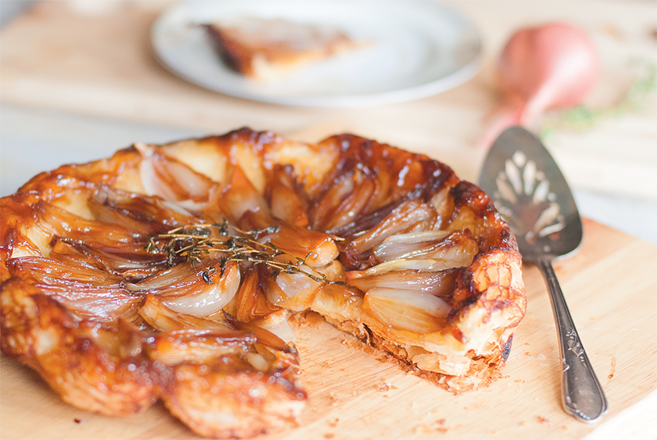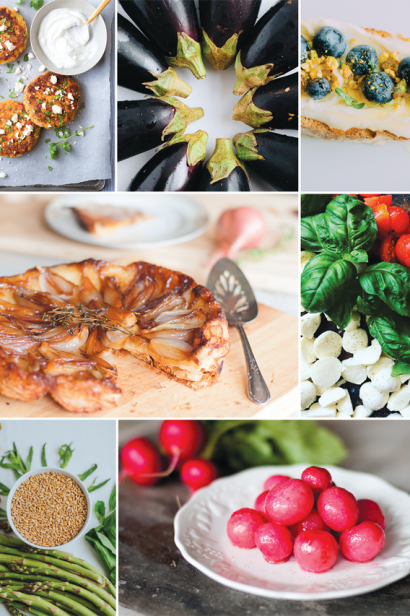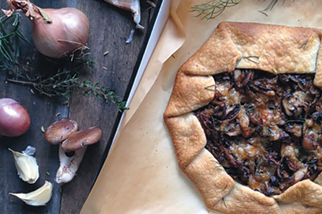Making Food Photos Sing
We love our food. We shop for it, we prepare it, we eat it—and we photograph it constantly, as if it were a favorite child.
But what can we do when our lovingly conceived photo of a juicy bite of steak turns out like an ad for a horror flick?
Women Who Shoot
To find out how the professionals turn food into art, we gathered four Edible Columbus food photographers and stylists to talk about their craft. All are self-taught.
• A graduate of The Ohio State University in English, Hilliard native Maria Siriano worked in publishing, freelanced as a copy editor, sold baked goods at local farmers markets and created a food blog. By “perpetually emailing” Faith Durand of thekitchn.com, Maria became a regular contributing photographer for Kitchn, shooting the second edition of Faith's book, Not Your Mother's Casseroles. She now specializes in cookbook photography.
• Newark–Columbus–New York City–Columbus. Bridget Henry’s journey was originally as a make-up artist whose food blog and Instagram feed were a side interest, until an admiring client recommended she try food styling. Today, Bridget works mainly as a food prop stylist for large accounts like Oneida and small ones like EC. Her mission: help the food “tell a beautiful story” through props and styling.
• Born in Moscow (the one in Russia, not Ohio), Maria Khoroshilova graduated with a journalism/graphics degree. She was inspired to become a photographer by the blog of a documentary wedding photographer that “showed moments and emotions—like a crying dad.” She admires “the articles and the quality” of Edible Columbus. “It’s so cool to learn about local food and its impact.”
• As the daughter of Columbus restaurant owner Hany Baransi of Nazareth restaurant, Rachel Joy Barehl grew up surrounded by food, but she began her career with wedding photography. Her first food shoot was a Thanksgiving gathering for thekitchn.com, then website photography for Cara Mangini’s Little Eater Café and a cover photo for her cookbook The Vegetable Butcher. Rachel is drawn to the “fast, real, imperfect nature of photography.”
The Thought Behind the Shot
Compared to the “too perfect” food photography of the ’60s and ’70s, the four photographers agree, today’s images strive to be authentic and natural.
“I find textures in real life beautiful,” Rachel says. Maria K adds, “I like beautiful-mess photos that are not that perfect. You can see that there’s been a human there.”
Which is not to say that there is no forethought or artifice involved. Maria S styles and shoots in her studio, and the creative process involves a prodigious amount of organization.
“I usually shoot recipes,” she says, “so I browse Instagram and Pinterest for similar foods and make a mood board of ideas,” including art direction from the client. After finalizing the shoot’s direction, “I gather my props, pick the surface and lighting and make the recipe. I mess around with different platings. Then I shoot it.”
She may perk up a dish with a spritz of water, but “there is so much waste in food styling,” Maria S says. “My philosophy is to keep waste to a minimum, and not make the food I shoot inedible.”
Bridget concentrates on food prop styling. She, too, makes a mood board and considers client preferences, sometimes including the home and make-up trends that she also follows.
“Right now, for example, you see pink and rust and yellow in home colors. So, it’s cool to bring it into the food world with pale pink plates.”
With her food photos, Bridget wants to “tell a story and make it beautiful,” which means she often uses “things I love” from her home.
“I take my marble bowls everywhere,” she says. And she is obsessive about finding “the best radish” and “the most beautiful lemons” for her shots, often spending 30 minutes at the grocery aisle or market stand auditioning her produce.
In contrast, Maria K and Rachel usually work without a studio, often shooting on location at a farm or restaurant.
For Maria K, the shoot is akin to a scavenger hunt.
“I work with what’s there. And if something seems to be missing, I go look for it; I search for something to use as a prop. I might change a dish from a square one to a round one, or add something not necessarily in the recipe. For a shot of toast, I had coffee, bread and a bread knife, a tea towel. But the toast still looked lonely on the plate, so I sliced some bananas and added them. And then it was okay.
“I work in terms of feeling,” she says. “Food is a very human thing; everybody has to eat. But sometimes food is dull. Then, okay, parsley!” She mimes sprinkling parsley over a recalcitrant dish.
Rachel has learned to capture a wedding’s ephemeral moments, so for food, she also tends to look for a minimal background and good light, and then shoot quickly. “Having met the farmers who grow the food makes photographing food much more meaningful to me. I want to help businesses succeed, and making good photos will help them.”
She shows me a photo of a shiny purple flower that on closer inspection resolves into a clutch of eggplants arranged in a circle to suggest petals and stamens.
“I also try to make something ordinary, like a vegetable, appear extraordinary. It can be slicing it, making a pattern out of it, shooting super zoomed-in to capture texture and detail. There has to be an element of fun in it.”
Inspiration & Passion
Inspiration? Pinterest, Instagram, “real life”—even the still lifes of the Old Masters get a nod, but all these women sigh in tribute at the mention of cookbooks.
“Have you seen The Four and Twenty Blackbirds Pie Book?” Maria S asks. “The photography.”
Bridget agrees enthusiastically. “And Cook Beautiful!” She cradles an imaginary copy. “I was lovingly stroking the pages—it’s so beautiful!”
The take-away from our conversation is that the beating heart of a beautiful food photo lies in the passion of the photographer—that connection with their subject that makes a photo sing, and makes the reader take a second look.
Tips From The Pros
The top tip: Shoot in natural light when possible.
Lighting
In a restaurant, sit near a window. Loosen the light bulb at your table so it’s not shining on your food. Maria K
When you shoot, turn off the other lights in your house. Rachel
Use clouds as a natural diffuser of light. Bridget
Use a large, white napkin or even an old white bedsheet to diffuse harsh lighting. Maria S
Composition
Scoot everything close together. Rachel
Use different, natural surfaces like slate, marble, a wooden crate. Bridget
Make a space around your food. Maria K
Layer your shot. Put a linen on the table, a bowl to one side, a garnish on the dish. Maria S
Camera type
Rachel and colleagues argue that “a good window is more important than the camera you use.” But since we asked:
Maria S: Nikon D610. Favorite lenses: Nikon 50mm f/1.4, Nikon 105mm f/2.8
Maria K: Nikon D750, D300. Lenses: Nikon 50mm f/1.4, Nikon 35mm f/1.8
Rachel: Canon EOS 5D Mark III and Mark IV. Lense: Sigma 50mm f/1.4
Bridget: Leica D-Lux 4 camera for shoots and iPhone X for social media
Apps
VSCO iPhone and Android app: The unanimous choice for editing photos, for its “really good filters” and ease of use. For in-depth editing, Adobe Lightroom.
Artifactuprising.com: Not an app, but a highly recommended website for printing digital photos.









